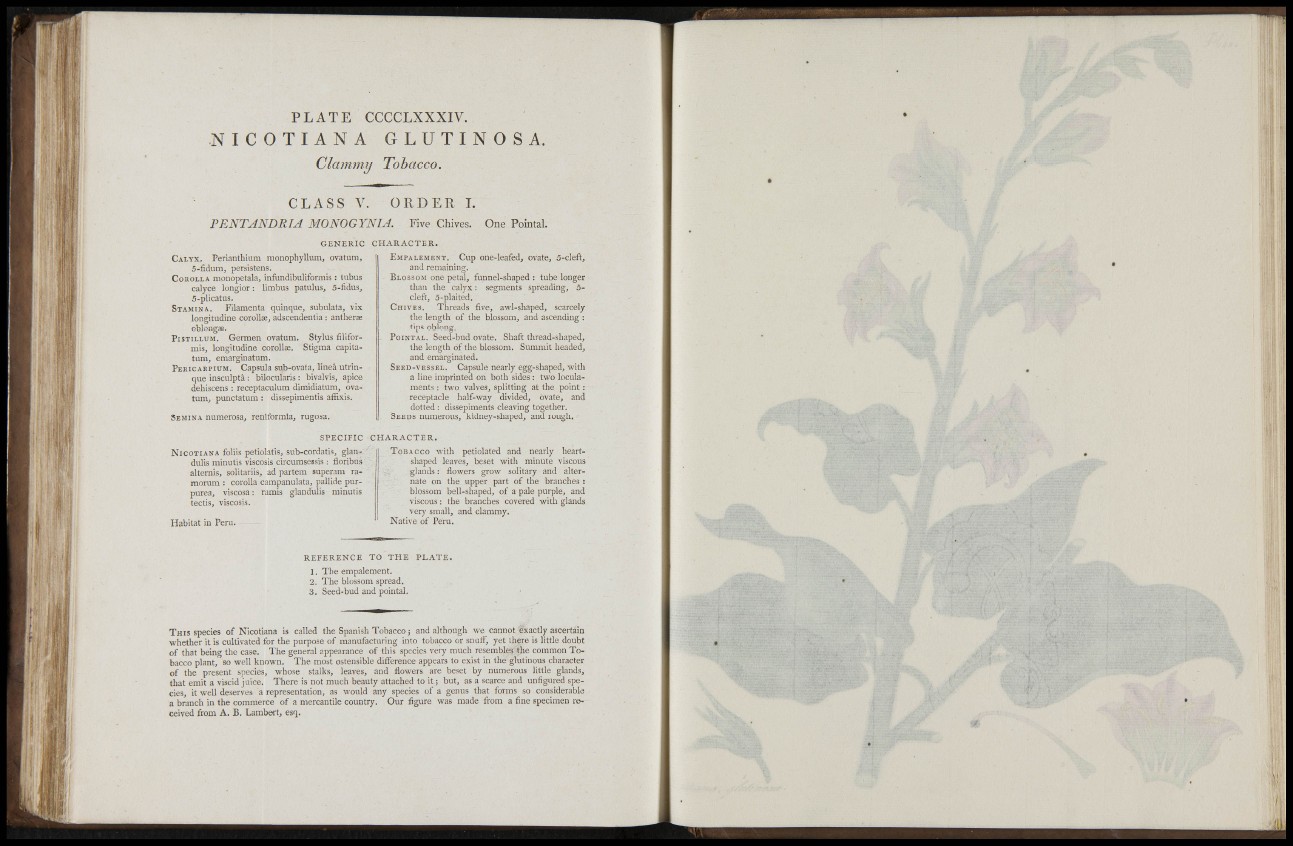
' Mi
h i p :
PLATE CCCCLXXXIV.
N I C O T I A N A GLUTINOSA.
Clammy Tobacco.
CLASS V. ORDER L
FENTANDRIA MONOGYNIA. Five Chives. One Pointai.
GENERIC CHARACTER.
CALYX. Perianthium raonophyllum, ovatnm,
5-fidum, persistens.
COROLLA monopetala, ¡nfundibuliformis : (ubus
calyce longior : limbus patulus, 5-fidus^
5-plicatus.
STAMINA. Filamenta quinque, subdata, vix
longitadine corollae, adscendentia : antherae
oblongae.
PISTILLUM. Germen ovatum. Stylus filiformis,
longitudine corollée. Stigma capitatami
emarginatura. .
PEKICAEPIUM. Capsula sub-ovata, linea utrinque
insculptà : bilocularis : bivalvis, apice
dehiscens : receptaculum dimidiatum, ovatum,
punctatum : dissepimentis afnxis.
SEMINA numerosa, reniformia, rugosa.
Î^MPALEMENT. Cup one-leafedj ovate, S-cIeft,
and remaining.
BLOSSOM one petal, funnel-shaped : tube longer
than the calyx : segments spreading, 5-
cleft, 5-plaited.
CHIVES. Threads tive, avvl-shaped, scarcely
the length of the blossom, and ascending :
tips oblong.
POINTAL. Seed-bud ovate. Shaft thread-shaped,
the length of the blossom. Summit headed,
and emarginated.
SEED-VESSEL. Capsule nearly egg-shaped, with
a line imprinted on both sides : two loculaments
: two valves, splitting at the point :
receptacle half-way divided, ovate, and
dotted ; dissepiments cleaving together.
SEEDS numerous, kidney-shaped, and rough.
SPECIFIC CHARACTER.
NICOTIANA foHis petiolatis, sub-cordatis, glandulis
minutis viscosis circumsessis : floribus
alternis, solitariis, ad partem superara ramorura
: corolla carapanulata, pallide purpurea,
viscosa : ramis glandulis rainatis
. tectis, viscosis.
Habitat in Peru. -
TOBACCO with petiolated and nearly heartshaped
leaves, beset with minute viscous
glands: flowers grow solitary and alternate
on the upper part of the branches :
blossom bell-shaped, of a pale purple, and
viscous: the branches covered with glands
very small, and clammy.
Native of Peru.
REFERENCE TO THE PLATE.
1. The empalement.
2. The blossom spread.
3 . Seed-bud and pointal.
THIS species of Nicotiana is called the Spanish Tobacco; and although we_ cannot exactly ascertain
whether it is cultivated for the purpose of manufacturing into tobacco or snaif, yet there is little doubt
of that being the case. The general appearance of this species very much resembles the common Tobacco
plant, so well known. The most ostensible diiference appears to exist in the glutinous character
of the present species, whose stalks, leaves, and flowers are beset by numerous little glands,
that emit a viscid juice. There is not much beauty attached to i t ; but, as a scarce and unfigured species,
it well deserves a representation, as would any species of a genus that forms so considerable
a branch in the commerce of a mercantile country. Our figure was made from a fine specimen received
from A. B. Lambwt , esq.
..'li